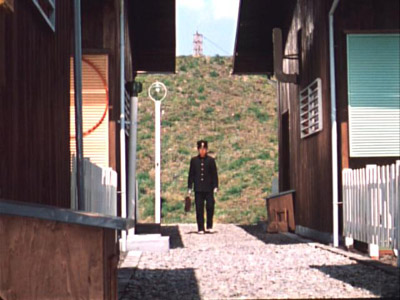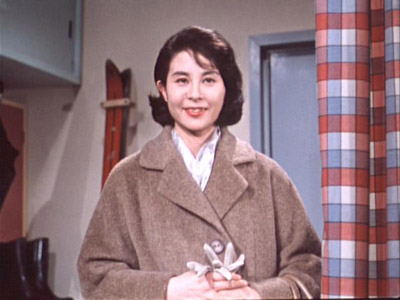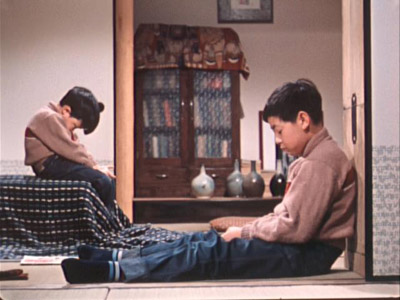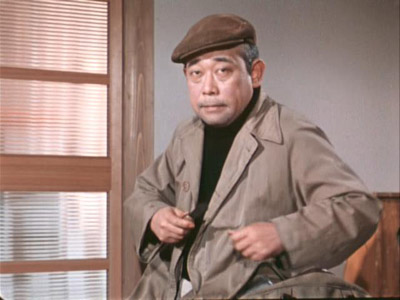Good Morning, 1959, directed by Yasujiro Ozu, written by Yasujiro Ozu and Kôgo Noda.
A day or two after I first saw Good Morning, I received an email from Ozu fan and Criterion Contraption reader Lewis Saul urging me to watch any of his other films before this one. Apparently, Good Morning isn't emblematic of his work, and he was afraid I would get the wrong impression about Ozu if I started with this one. Well, I got the email a day late. I still haven't seen Tokyo Story, or any other films Ozu directed, but I certainly get the impression the bulk of his work is quite different from Good Morning. At the very least, the film seems a bit out of synch with his reputation. Peter Bradshaw, in an appreciation for The Guardian, characterizes Ozu's work as "gentle quietism and transcendental simplicity." I suppose you could argue that Good Morning shares those qualities, as long as you find something gently quietistic or transcendentally simple about the film's opening and closing scene: a farting competition that ends in tragedy when a young boy craps his pants.

Still, you know you're in the hands of a master director from the first frame. Ozu captures all the details a lesser artist would have missed, down to the uncomfortable, shuffling walk.

So this is not, perhaps, Ozu's most transcendentally simple or gently quietistic work. It certainly had a lot more scatological humor than I was expecting. Which is strange, because it's shot in a style you might, in fact, describe as transcendentally simple. When I wrote about Seijun Suzuki (Branded to Kill and Tokyo Drifter), I said he'd developed his own cinematic grammar, which I'd never seen before. Ozu doesn't have a grammar tied to thematic elements, the way Suzuki does, but he does have strict rules for shooting, which seem to have little connection to what's going on onscreen.
The first thing you'll notice about Ozu's style in Good Morning is also the simplest: he never, never, never moves the camera. No dolly shots. No zooms. No tracking around the room. He'll cut to a different angle, but every shot is static. You can't illustrate this with a still, obviously, but it's pretty striking.
The second thing can be illustrated: Ozu often shoots conversations head on. Whether this violates the 180° rule depends on whether or not you think exactly 180° is permitted. For example, he shoots a conversation between Keiji Sada and Yoshiko Kuga by cutting from this:

To this:

I can say at the very least it's a little disorienting. Also note the slightly low angle, another Ozu trademark. Wikipedia refers to this as the "tatami shot," because the camera is placed at about the height one's head would be while kneeling on a tatami mat. Of course, to maintain that angle, Ozu had to get the camera even lower when he was shooting people who actually are kneeling on tatami mats.

Since Ozu didn't have to worry about a moving camera, each shot is very carefully composed. So Good Morning is full of lovely symmetries like this shot of Minoru and Isamu sulking:

Most people list those two kids (played by Koji Shitara and Masahiko Shimazu) as the film's main characters. I suppose that's fair: a major plot throughline involves those two deciding not to speak until their parents buy them a television. But that doesn't happen until nearly halfway through the movie. People remember Minoru and Isamu more than the rest of the film, because after a certain point, Ozu stays with them. It also doesn't hurt that Masahiko Shimazu appears to have been cast in the film after winning the Most Adorable Kid In The World Contest.

But the fact is, a lot of Good Morning isn't about them. The first half of the film follows a group of gossiping housewives trying to figure out what's happened to the dues they were supposed to pay to some neighborhood organization or other. There are enough subplots that it's hard to find a throughline that lends itself to plot summary. So although Minoru and Isamu's strike ties together a lot of the film's themes, I think it's more accurate to describe Good Morning as a portrait of a small Japanese community lurching towards modernity.
The structure of the film bears this up: it's a series of loosely connected comic vignettes, which may share characters and locations, but tend to have narratives of their own that resolve themselves independently of the rest of the film. My favorite of these sequences was not too surprising, given my predilection for con artists. Each of the houses is visited in the middle of the day by a door-to-door salesman, peddling overpriced household goods. When the women aren't interested, he sits down, casually, and urges them to at least buy a pencil. He pulls out a pocket knife and demonstrates how easy they are to sharpen, especially with such a sharp knife.

Not suprisingly, buying a pencil seems a lot more attractive as soon as the salesman pulls a knife. A few hours later, the same women are visited by a different salesman, a nice, much less threatening young man. He's selling alarm bells that can be used to summon the police in case of harrassment by pushy salesmen. Not surprisingly, everyone's interested. Later, we see the two men going over the day's take at a bar. The only household that's spared is the Haraguchis', where the grandmother insists on sharpening the pencil herself. With her own knife.

The salesman looses interest at that point. The grandmother is played by Eiko Miyoshi, and she's hilarious whenever she's onscreen. I also enjoyed Eijirô Tono's turn as a man forced into retirement too soon. His performance strikes just the right balance between sadness, anger, and alcoholism.

Tomizawa's retirement is the closest the film comes to getting serious. Ozu strings a few thematic concerns through most of the vignettes: anxiety about Westernization, lack of respect for the elderly, the way people use small talk to avoid saying what they're actually thinking, youth's sense of entitlement (though Asia hadn't seen anything yet), the forced intimacies between neighbors who would ordinarily loathe each other. It's obvious why problems with neighbors were particularly interesting in Japan of the late 50s: city planners seem to have been trying to duplicate the feel of the Tokyo subway at home:

There's a joke about rat poison towards the end that made me wonder if the movie was about to become pitch-black (it doesn't). The essays I've read about Good Morning make a great deal of hay out of the subtext; the thematic concerns I'm mentioned about. But since virtually every other scene has a fart joke in it, it's difficult to see this as some great statement about Japanese culture. Not that that's a bad thing—I'm ok with fart jokes.
I can't think of any other movie that looks quite like Good Morning(except, apparently, all the Ozu films I haven't seen). But as with Wes Anderson, the salient question is what the style is in service of. In the case of Good Morning, I think there's a disconnect between the style, which seems contemplative and a little sad, and the subject matter.
It's not that the film is without its wistful, thoughtful scenes, where Ozu's style seems appropriate. It's not a farce; it has its moments of languor. But the overall tone is wry, and the basic structure is that of a comedy of manners. I felt like the frozen camera was continually fighting with the subject matter and tone. Even in scenes that were charming and funny, there was something that seemed a little off about the whole endeavor.
It isn't entirely clear to me why some styles of filmmaking should suit particular genres. Obviously, some techniques can reliably produce particular results: cutting suddenly to a shot of the killer right behind the victim will always make an audience jump, point-of-view shots that don't appear to belong to any particular character give a sense of unease, and so on. Shock cuts are not a learned association, they tap into the startle reaction. But the link between point-of-view shots and unease could be learned, because most times you see that technique, a shock cut is just around the corner. I've never seen another film with as completely static a camera as Good Morning, but the closest things I've seen have all been dramas. I wonder if there's something about Ozu's style that is intrinsically better suited to drama than comedy, or if I could have associated Ozu-like camerawork with comedy if, say, Ghostbusters or Airplane! had been shot that way. But they weren't, and Good Morning didn't do much for me. I probably should have watched Tokyo Story first.
Randoms:
- Both Eiko Miyoshi and Eijirô Tono are stealth candidates for "most appearances in the Criterion Collection." She's in in countless Kurosawa films, plus two of the Samurai movies. He worked with Ozu and Kurosawa a lot (if I have this right, he is the kidnapper who staggers out and dies in the begining of Seven Samurai), and is also in two of the Samurai films.
- Ozu has a head-on shot of Isamu and Minoru watching television, a rarity in the pre-genlock days.

- As you can see, he avoided scan lines by cutting out the screen on the original image and pasting in a film image of the show they're supposedly watching. It's pretty apparent that you're not seeing the image on a CRT (it looks very flat, and there's no glare). Ozu's style comes in handy here, however, because the only way this effect can work at all is if you shoot straight on and never move the camera.
- There's a nice, reassuring appreciation of Ozu by Mindy Aloff that ran in the Times in 1994. Reassuring because it took her several films to really get Ozu.


19 comments:
This is a very well-accounted description of what it's like to experience Ozu for the first time, pretty much hitting the middle ground between those who experience a revelation and those who are left cold. Your precise observations are valuable to both sides.
The transcendental label on Ozu is way overemphasized - I suppose we have Paul Schrader to thank for that. What gives Good Morning a solid throughline with his oeuvre is the sensitivity to the nuances of human interaction rendered in cinematic terms (editing, mise en scene). Jonathan Rosenbaum gives a wonderful account of this film - I believe it's in his book PLACING MOVIES - specifically identifying its central theme of exploring the various means of human communication in Japan circa 1957, from television (I think this was the first Ozu film to feature a television set, making your keen observation on how he approached that challenge all the more pertinent) to door to door salesmen to social calls to the private fart jokes of boys. It's all part of the social fabric that's essential to Ozu's interests.
Anyway stuff like the fart jokes are actually not new to Ozu's work - in the 30s he indulged in a fair amount of juvenile humor, especially with his schoolboy movies like I GRADUATED, BUT... and I WAS BORN, BUT... (elements of which are reappropriated for GOOD MORNING, such as the two boys).
A great article. I'm an Ozu fan, though I haven't watched all his films yet. Yes, for the "uninitiated," Ozu's cinematic style is "different." I read up on him before I ever watched an Ozu film for the first time, which was "Late Spring." In my opinion, "Late Spring" is ever-so-slightly better than "Tokyo Story."
If I may be allowed, one quote about Ozu's work that I find informing is from the documentary "I Lived, But..." (it's included on Criterion's edition of "Tokyo Story"):
"Ozu didn't use low-angle shots just for style. Ozu got to the heart of Japan. He really got to the heart of what ordinary people were like. In order to do that, he had to use Japanese-style rooms with shoji screens, futon pallets and tatami mats, all straight lines and right angles. Low camera angles are best for filming a setting like that. Then, he confined living beings within these rigid forms. I think he was trying to express his ideas through that. That's why he never panned or moved the camera. No high-angle shots either. The camera angles with which he was most comfortable bound him within narrow limits. If you don't have strict limitations, you probably won't think your ideas through so carefully. Those limitations make you condense your thoughts into a more concentrated form. That creative process is something you can't do without." - Kaneto Shindo, film director (english translation)
Great review!
I've not seen any Ozu yet. That said, do you think this structure is similar to that of Burnett's KILLER OF SHEEP?
Do housing complexes lend themselves to disconnected slice-of-life vignettes?
Nice review. I think you'll start to "get" Ozu after seeing a couple more films - suddenly you'll slip into the rhythm and that's when the 'transcendent' thing happens. It took me a while, but now I just choke up at every perfectly-framed shot, even when nothing is happening. It's weird. Ozu is not of this earth.
alsolikelife,
Thanks, glad you enjoyed the essay. I'm going to get Placing Movies from the library and will comment again when I've read it.
Roy,
That's a great quote—thanks for posting it!
NotUltros,
I haven't seen Killer of Sheep, so I can't say. But if you're looking for disconnected slice-of-life vignettes, you basically can pick between housing complex, subdivision, airport, hotel, or cruise ship.
Chekhov,
I'll look forward to that when I see more Ozu.
I actually think Good Morning is a great place to start an Ozu journey. A lot of Ozu's films are about the tiny (to everyone else) transitional moments that define life. One of the reasons I think Tokyo Story became *the* Ozu film in the West is perhaps because it tackles more of the 'big issues' of death and seems to be making much more of a statement on society as a whole shown through the indifference of the children (I think somewhere Ozu said it was his most melodramatic film).
I much prefer the rest of Ozu's output, including Good Morning, for the way that every 'life lesson' remains very specifically attached to the characters and their environment and that greater truths and social trends that we can take away and think about are hinted at but fundamentally remain just that family's experience of buying a TV set or those particular businessmen fleecing the community!
I think that is what divorces style from content - the comedy and drama doesn't play as pure self consciously comic or dramatic (though the farting and pants pooing scenes come close! But I think they are balanced with the old gentleman being blissfully unaware (or is he?) of his breaking wind and the kid's overriding embarassment at having to have his pants cleaned and having the reason for his problem misinterpreted by his mother! The after-effects are more important than the act itself!) and it is left to us to witness these tiny moments, insignificant to anyone beyond the individual characters, and find the comic or tragic elements in them that goes unnoticed in the course of things.
I really wish that Ozu directed a period film once. It would have been interesting to see. There are some directors (to stay in that country, Ichikawa is a good example) who can do any genre. Ozu is not one of them, and I would like to see how he would have tackled it. Probably would have been a family genre.
My problem with my first Ozu (Tokyo Story) was that for a while it was, and I put my film scholar neck on the critical block here, a bit boring. The static camera, the mostly unmoving people, his refusal to do simple elisions, all started to bore me. but after a while I started to get in sync with its pace and it was, for lack of a better word, relaxing. Not to say it was dramatically easy, but an Ozu would be good to watch after seeing something like Aliens. It's a bit like Barry Lyndon.
One thing I like about Ozu is hat he isn't afraid to have images with no symbolic significance. He will often have beautifully composed shots in the pictures for no reason other than that they are quite good looking. And he arguably has the best sense of composition of all Japanese directors a group who collectively have mastered composition.
What interested me about Ozu is that for such a humanist director, he was a bit of a bastard. A nasty story with a young Shohei Imamura is that Imamura was working as Assistant director on one of Ozu's films (I won't say which to avoid spoiling) in which a prominent character died of a brain tumor (I think). Which is what Imamura's mother (or grandmother) died of. Imamura was so distraught he fled to the bathroom to cry, and Ozu went in later, and while he was peeing said "Well, Shohei, how accurate was it?" A bit heartless, to say the least. (Imamura later said great directors needed that sort of dedication.)
Ozu did do one period film, his first in 1927 called Sword of Penitence. There are a couple of clips on it in the documentary on the Tokyo Story disc and I agree that I would like to see what Ozu would have done outside his 'comfort zone'. I'm more glad for his in depth work in this particular area however.
Worth mentioning that this is one of the few Ozu films that kids might like. My 10-year-old (who is used to older & foreign films, admittedly) was entranced by it when I rented it from the DVD shop--we watched it on a Friday night & on Saturday morning she played it all over again.
This is unfortunately one of Criterion's less-satisfactory DVDs--blurry image & NO extras. Still, worth seeing. I think I got interested in seeing it because of a passing reference to it in Rosenbaum's piece on Jacques Demy, where he parallels its quiet celebration of social formalities & small talk with The Umbrellas of Cherbourg's way of making (literal) music out of daily commonplaces. -- My favourite scene in the Ozu film (I guess you could even call it its "climax") is the wonderful scene of courtship, conducted entirely as an exchange about the weather.
Re: the static camera: I seem to recall that in Late Spring there's a moment with two tracking shots cut together--in the context of Ozu's style it's so striking & different that it takes the top of your head off.
The "flat" way of filming dialogue as two direct addresses to the camera is also found in Naruse, so maybe it was a common style in the period? (someone who actually knows Japanese cinema well might add a comment here). It'll be a while till you get to Naruse's When a Woman Ascends the Stairs in the Criterion Collection, but there are some good instances there.
"I seem to recall that in Late Spring there's a moment with two tracking shots cut together"
Yes, but the actual angle doesn't change, if I recall. No pan.
"maybe it was a common style in the period?"
It wasn't unique, but it wasn't common. Japanese cinema does have some noticable differences from Western cinema (strict attention to composition, utter inability of certain characters to shut the hell up--Japanese reticence never really made it into their cinema). However, it isn't quite that unique, and the basic "grammar" is the same.
"I seem to recall that in Late Spring there's a moment with two tracking shots cut together"
Yes, but the actual angle doesn't change, if I recall. No pan.
"maybe it was a common style in the period?"
It wasn't unique, but it wasn't common. Japanese cinema does have some noticable differences from Western cinema (strict attention to composition, utter inability of certain characters to shut the hell up--Japanese reticence never really made it into their cinema). However, it isn't quite that unique, and the basic "grammar" is the same.
colinr0380 -- in an excellent response -- said:
>>>I actually think Good Morning is a great place to start an Ozu journey. A lot of Ozu's films are about the tiny (to everyone else) transitional moments that define life. One of the reasons I think Tokyo Story became *the* Ozu film in the West is perhaps because it tackles more of the 'big issues' of death and seems to be making much more of a statement on society as a whole shown through the indifference of the children (I think somewhere Ozu said it was his most melodramatic film).
And of course, in Tokyo Story, the "children" are adult children -- which makes the message even more powerful -- they act almost exactly like the kids in Good Morning -- pouty and selfish (esp. the Sugimura character!)
Matt -- terrific job, esp. w/the captures -- you bring the film to life for your readers.
It's a long wait until Tokyo Story.
But there are plenty of great films coming up!
I can't wait!
Lewis Saul
There are many camera movements in Ozu's prewar films, and occasional ones in his films of the 1940s and 1950s (there are some glorious examples in EARLY SUMMER), but once he started using color, he gave up on camera movement.
David Bordwell, Ozu's best critic, notes that it seems that Ozu felt that by taking on one new stylistic element, he had to throw another overboard. If this sort of perverse logic appeals to you (and boy does it ever appeal to me), you'll have a lot of fun with Ozu's style, which is built by drastically narrowing the stylistic palette of narrative cinema and then working unfathomably complex variations on what's left. I could be mistaken, but OHAYO may be one of the films where the last shot of the film is effectively a "reverse shot" of the first.
A comment above mentioned that Ozu used scatological humor in his early films. The title card of I WAS BORN, BUT... features a naked boy among some fronds embarrassedly covering his genitals with his right hand, a totally irreverent Botticelli reference. Crotch-grabbing is a prominent motif in the film. In all sincerity, I suspect you would love that one, Matthew. It's on the SILENT OZU: THREE FAMILY COMEDIES set, as worthwhile an investment as any cinephile can make.
Great piece, Matthew. I'll chime in with the rest about Late Spring -- it's gorgeous. The simplicity builds to a very emotional, still simple payoff. I recently saw it, my first Ozu, and I'm looking forward to more.
Also, you have to see Killer of Sheep. I'm curious if it's out on Criterion -- if it is, I'm excited; I think you'd do a terrific job with it.
I see you haven't posted since April. When can we expect a return?
And just a word about the fine knitwear in the film!
Post a Comment